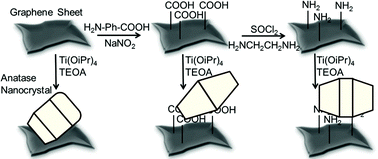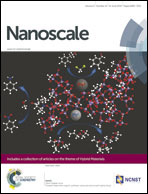Tuning TiO2 nanoparticle morphology in graphene–TiO2 hybrids by graphene surface modification†
Abstract
We report the hydrothermal synthesis of graphene (GNP)–TiO2 nanoparticle (NP) hybrids using COOH and NH2 functionalized GNP as a shape controller. Anatase was the only TiO2 crystalline phase nucleated on the functionalized GNP, whereas traces of rutile were detected on unfunctionalized GNP. X-Ray Photoelectron spectroscopy (XPS) showed C–Ti bonds on all hybrids, thus confirming heterogeneous nucleation. GNP functionalization induced the nucleation of TiO2 NPs with specific shapes and crystalline facets exposed. COOH functionalization directed the synthesis of anatase truncated bipyramids, bonded to graphene sheets via the {101} facets, while NH2 functionalization induced the formation of belted truncated bipyramids, bonded to graphene via the {100} facets. Belted truncated bipyramids formed on unfunctionalized GNP too, however the NPs were more irregular and rounded. These effects were ascribed to pH variations in the proximity of the functionalized GNP sheets, due to the high density of COOH or NH2 groups. Because of the different reactivity of anatase {100} and {101} crystalline facets, we hypothesize that the hybrid materials will behave differently as photocatalysts, and that the COOH–GNP–TiO2 hybrids will be better photocatalysts for water splitting and H2 production.


 Please wait while we load your content...
Please wait while we load your content...